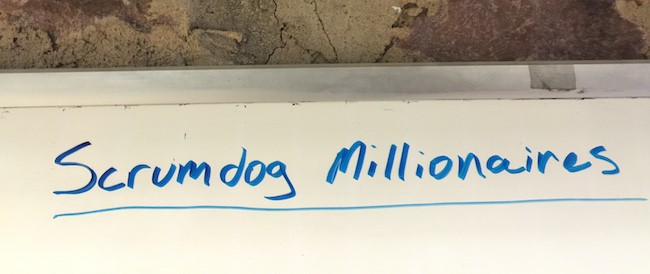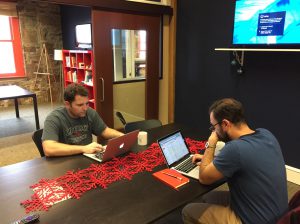
Marketing Scrum Rundown: Did Agile Marketing Work for 9 Clouds?
“We’re going to do a scrum.”
What’s your first reaction to that? It’s probably one of two things: You’re thinking about a pack of rugby players trying to gain control of the ball or you’re thinking of agile marketing, a.k.a the scrum methodology.
In my case, I was thinking of a variation on the first. I was thinking about Ross, from Friends, getting his ass kicked by a bunch of Brits to impress a lady friend.

Not a stunning scrum success.
The good news for everyone at 9 Clouds: we didn’t do a rugby scrum. That would’ve been a disaster. But we did try a marketing scrum. Here’s what we learned from our two-hour agile marketing scrum. We hope you use our experience to potentially put together your own scrum and see if it works for you.
Preparing for the Scrum-Down
Scrum in the professional sense originated with software development teams trying to get complex problems finished in a finite amount of time. It’s since been adopted by different trades, each one gently tweaking the system to make it their own.
For marketing, the scrum methodology turned into agile marketing, something really embraced by inbound marketers. Think about it: agile marketing wouldn’t go over well in the stodgy, traditional world of outbound marketing.

✓ and done
As inbound marketers, we were excited to try a new concept of production. Here’s how we really took the idea and put it to work for our team.
We decided to take a specific, complex project — eBook creation — and set a finite two-hour time limit for our team to finish.
Beforehand, a project manager on our team collected content, prepared logos and planned the tasks. Because we gave ourselves a short time limit, we put post-it notes on our conference room windows to keep track of which tasks were up for grabs or finished.
This gave us a visual reminder of what was left to finish as the clock ticked down and helped track who was working on which projects. Plus, it looked cool. There’s no harm in having a little fun with your scrum.
Scrum Execution
The first step of the 9 Clouds Scrum was a team meeting, where we answered some vital questions about our project:
- What is the ultimate goal of this eBook? (To answer this we determined important things like our SEO focus keywords and value proposition.)
- How can we best get it done? (Here we focused on our team’s strengths to self-assign the projects.)
Marketing Scrum: Nothing Like Rugby
From there, it was all action. Everyone grabbed the post-it they wanted to work on and we got to work.

January and we’re still decorated for Christmas. Lazy? No, we call this festive.
When I say “all action,” though, I don’t mean physical action. We were kind of expecting a hectic, newsroom sort of feel, where everyone was working together and yelling for this graphic and that font.
What we got was a pretty normal afternoon in the office.
Our team works quietly most days, with headphones in and our conversations taking place on Slack. The scrum didn’t change that at all.
Scrumptious Experience (Kind Of)
The scrum did give us an opportunity to make plenty of scrumptious puns, though, so there’s a silver lining. But still, we were disappointed with how very regular the marketing sprint felt compared to a typical day in the office.
Disappointment with the atmosphere didn’t stop us from getting to work, though. Our own workflow did. Running through an eBook launch, we have a specific number of pieces to finish, but some of those are reliant on the eBook itself being completed.
This left some of our team waiting around while the other scrummers finished their work. And because of that, when the two-hour mark came around, we weren’t quite done with everything we set out to finish.
Scrum-in-Review
The final piece of every scrum is the review, where you examine how the processes worked and what needs improvement for the next time.
So how did we feel about the marketing scrum?
We felt pretty good, considering the fact that we didn’t finish.
With an eBook, we now realize the scrum should’ve been more like a waterfall, with part of the team working on the eBook content and design over an hour and then the second part of the team spending the next hour on launch pieces.
We’ve also considered holding two separate scrums — one for eBook design and another for the launch pieces.
The great thing about our scrum is that we devoted two hours to it — not 10 or 40. Even if it had been a huge failure, we didn’t lose much time. This test scrum taught us important lessons to try next time — and to pass along to all of you. That learning experience is well worth the two-hour investment our team made.
Some of you might have given up if your first scrum was anything less than a smashing success, but for our team at 9 Clouds, we know we can always do better. We’re not naïve enough to think our first attempt — or hundredth attempt — at anything will be perfect.
Everything We Do is Scrum
Another big lesson for our team: almost everything we do falls under agile marketing.
The methodology utilizes daily meetings and public to-do lists, which creates a culture of transparency and adaptation. We’ve previously written about how we use Basecamp to manage both our client and internal work and Slack to stay in constant communication. Both of those platforms help us stay agile.
To be successful in inbound marketing, you can’t be satisfied with the status quo. You have to be open to changing the way you do what you do. Our culture internally is one of constant growth and that lends itself to success. The marketing scrum is just another tool we use to create the best work possible. Or at least, it will be once we hone in on the most effective way to use it.
Our team at 9 Clouds is always working to improve our productivity — and we’re happy to share our secrets.






